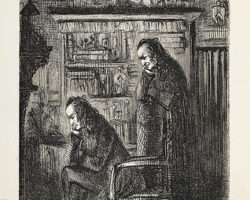
Over the last several years, I have made a habit of reading through Charles Dickens’ Christmas stories. There are five: A Christmas Carol, of course, and four others that are largely unknown, except perhaps for The Cricket on the Hearth.
This year I finished the last of these, The Haunted Man and the Ghost’s Bargain. The concept behind this story is fascinating. Mr. Redlaw, a chemistry teacher, is burdened by old memories of sorrow and wrongs done to him. He wishes he could be rid of such terrible memories. That night, a phantom comes to him in the likeness of himself. This ghastly doppelganger offers to take away these memories. There is a catch, though–Redlaw will also take away the memories of sorrows and wrongs from those he comes in contact with.
Redlaw makes the deal. This constitutes the events of the book’s first part. The consequences of this deal and the repair of the damage it causes make up parts two and three.
What Redlaw discovers–and what I find fascinating–is that bereft of memories of sorrow, wrong, and trouble, Redlaw and those he “infects” become cold and unfeeling toward one another. Warm relations between father and son, between husband and wife, between the well-off and the poor, become bitter, exacting, and petty.
The only character unaffected by Redlaw’s touch is a young street urchin who is more beast than child. This is because the child already lacks any humanizing influence in his life. Those Redlaw touches become less human, not more.
The moral of the story is summed up in this: “Lord, keep my memory green!” For Dickens, the memory of sorrows and wrongs have a purpose in our life. They soften us to others. They enable us to sympathize with our fellow man. They teach us to forgive those who have wronged us. They bind us to those who suffer with us or in similar ways. The remembrance of sorrow, according to The Haunted Man, is essential to a life of compassion, goodness, and joy.
The character of Milly represents this. She is an innocent, kind, quiet young wife who ends up counteracting Redlaw’s touch. Her interest in others, her concern for the less fortunate, are not only admirable and worthy of emulation, but (as we discover in the conclusion) are rooted in her own tragedy. She had built dreams of motherly affections upon a child who was stillborn. Now she cannot interact with others without thinking of her own unborn child–childless, she has become a mother to all.
This view of sorrow and wrongs as redemptive is deeply Christian. Christians have always believed sorrow is not meaningless. It has a purpose in God’s plan. We even have a Savior “slain since before the foundation of the world.” Though all sadness and injustice will eventually be eliminated, the remembrance of sorrows will, in some way, need to be part of life after Christ’s return, for the cross will still be the pivotal act in redemptive history.
Dickens, who in much of his work is striving to alleviate suffering, knows that we must remember suffering to make the lives of those around us better. Christmas and New Year’s are special times of remembrance for many. We look back at the previous year’s events. We stop and ponder what has come before and what might come after. The prayer, “Lord, keep my memory green!” is a good one for this time of year, and for all times of year. I think Dickens would argue, for instance, it would be better to remember 2020 than to try and forget it.
As for the story itself, it is typical Dickens in many ways. It includes idiosyncratic characters, like Johnny who babysits his little sister “Moloch.” It has its convenient coincidences and connections. It ends neatly and happily. But I count those as positives. It is Dickens, after all.
This book is not as iconic as A Christmas Carol, but I wish it were better known. I think it hits upon something true and beautiful. We have plenty of adaptations of A Christmas Carol. It would be interesting, some Christmas season, to see someone tackle The Haunted Man.